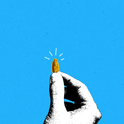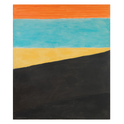When Jarvis Cocker crash-landed into mainstream pop culture in the mid-1990s, he cut an unusual figure among his Britpop contemporaries. He didn’t have the wry, knowing chops of Blur’s Damon Albarn, or Liam Gallagher’s sullen swagger. He was all whirligig limbs, spindly arms and spiky hips, equal parts camp and charisma, a cartoon character straight from the pencil of Quentin Blake.
He was also significantly older: 30 years old when Pulp released their first single on a major label (the sparkling, vengeful “Lipgloss”), and nearly 32 when their 1995 single, “Common People,” became a hit.
The same year, after the Stone Roses dropped out of headlining Glastonbury at the last minute, Pulp were asked to replace them and sing their own songs about the murky underbelly of working-class life. It was a victorious moment—and I know because I was there, a 17-year-old misfit from a steel-working town like Cocker (Swansea, in my case, not his hometown of Sheffield). I stood drop-jawed among the crowd in my tortoiseshell glasses, anorak and cheap shift dress, watching a band singing about ordinary lives I understood, on the biggest stage of them all.
In those dying days of John Major’s Conservative government, in those dreamy years when we thought that the Cold War had fizzled out, I remember the chorus of “Mis-Shapes,” a song about indie outsiders, being carried by thousands of people into the Somerset night. “We’re making a move, we’re making it now / We’re coming out of the sidelines,” Cocker sang. It really felt like we were.
Nowadays, Cocker is not only an elder statesman of British indie music but also a national treasure, editing books at Faber, hosting programmes on Radio 4, hobnobbing with Jeremy Deller, Sadie Coles and Peter Blake. Nevertheless, coming out of those sidelines has been laborious, awkward and often (literally) painful, as documented in his new memoir Good Pop, Bad Pop (Jonathan Cape, £20). Written in the form of an inventory of his loft where he’s “stored a lot of stuff” for the last 20 years, it’s certainly unusual.
The tone from the beginning is light, pithy and eager. “Imagine being inside a Toblerone packet,” Cocker writes of the three-foot-high loft he’s digging into. “The only way to look at things is to crawl -into the space, wriggle through the dust & cobwebs… it feels like mining.” At first, a packet of Wrigley’s chewing gum and some collar supports emerge. Not particularly promising.
But Cocker wants to remind us that he understands ordinary, mundane life. This is stressed further by the scrapbook style of the memoir—designed by Julian House, best known for his work with the Ghost Box record label—which takes British public information films, folk horror and the bold, retro art of mid-century Britain as its inspiration. The DIY creativity of that period, when Cocker was growing up and forming his band, is very much part of who he is. (Pulp were first formed when he was 15 years old, in 1978, the year I was born.)
Cocker’s writing style is rooted in vernacular chat. Every use of the word “and” is replaced by a jaunty ampersand to create the illusion of a conversation. “OK, enough scene-setting: close your eyes, stick your hand in that pile over there & see what you come up with…” is the last line of the introduction. This style is risky, teetering towards gimmickry. But as personal revelations appear against this casual backdrop, gradually and subtly, each of them gains a surprisingly fresh power.
The first big reveal is a science exercise book, detailing what will become the “Pulp wardrobe.” It includes duffel coats, “rancid ties,” jackets “made of strange materials” and drainpipe trousers. Pulp fans will note that this uniform isn’t a million miles away from the fashion for which the band became known (although Cocker admits the shirts became gaudier). He got these clothes from second-hand jumble sales but, crucially, formed his own style: “I was starting to do my own thing.”
During Cocker’s adolescence, punk had just exploded. He writes of being painfully aware of how much that movement is written about (“you might even be sick of hearing about it”) but still manages to capture its miraculous, cross-cultural appeal. To him, punk arrived like a magical agent of social mobility, and notably gave the young Cocker “the confidence and permission to join in.” Punk was also full of people giving themselves “funny names on purpose… Johnny Rotten… Lux Interior… Johnny Moped.” He drolly adds: “I was actually one step ahead of them because I didn’t even have to change mine.”
He was raised by a mum who gave up her place at art college when she was pregnant with him (“sorry, Mum”) and he includes here a startling wedding photograph of her and his father (“she looks very young & very scared”). His sister, Saskia, came along seven years later. Then his father left. His childhood was spent surrounded by women, which may explain his appeal to
female listeners.
There are also flirtations with death and disaster. At six, Cocker gets horribly ill with meningitis, and all his classmates send presents to his isolation ward (“people must really have thought I was about to snuff it”). When he’s finally better, there comes a “bombshell”: all his gifts have to be incinerated, in case they’ve been infected. Only one cheap plastic astronaut, sterilised in boiling water, survives, as a photograph included here proves.
But Good Pop, Bad Pop is far from a misery memoir. It pulses with the thrilling energy of adolescence and early adulthood. Nor does it wallow in cosy nostalgia. Cocker uses his objects to tell real stories about the past, leaving in the dirt and disappointment around the moments of excitement.
For instance, he believed for years that a Marianne Faithfull record his first long-term girlfriend bought for him was full of precious meanings. But when she attends a Pulp gig in 2012, she reveals it was a random purchase from WH Smith. Cocker also discovers the truth about how the meningitis and his terrible eyesight are connected; broken pairs of glasses litter the pages of this story like comedy props.
Other images provide lovely moments of resonance. After Cocker writes sweetly about his love of John Peel’s radio show, which would later champion Pulp, the order of service for Peel’s funeral in 2004 is included without comment.
A picture of a record shop carrier bag provokes Cocker brilliantly to sum up the pop charts as a “crazy collision of rampant commerce and grassroots democracy,” long before downloads and streaming changed the music world’s rhythms forever. He then leaps to the work of a Soviet-era cinema verité pioneer. “Dziga Vertov’s dream of a self-generated proletarian art form made manifest. In the record department of Woolworths. Good pop.”
Class broils and rages through all of Cocker’s work. Listen to “Common People” today and the lyrics of its middle eight still pack an incredible punch: “You will never understand / How it feels to live your life / With no meaning or control / And with nowhere left to go.” The way he dealt with “the horror of Thatcher’s Britain,” he says, “was to sleep a lot.” He celebrates the creativity that emerges from poverty and pain. What he calls his lightbulb moment came in 1985, after falling out of a window while trying to impress a girl. Recovering in hospital, he made notes about the characters in his ward. A decade later, he was pop’s Alan Bennett.
The book finishes here, nodding toward Cocker’s move from Sheffield to London and Saint Martin’s (where he actually met a girl from Greece with a thirst for knowledge) and his rise to fame. Surely a second volume is a done deal. There must be many more items buried in those boxes and bags, awaiting rediscovery.
As Cocker pores over a collection of plastic toys from his childhood—a skeleton, a Father Christmas, an approximation of a smoker’s pipe—he neatly sums up what he is trying to do: “the idea that a culture could reveal more of itself through its throwaway items than through its supposedly revered artefacts was fascinating to me. Still is.”












